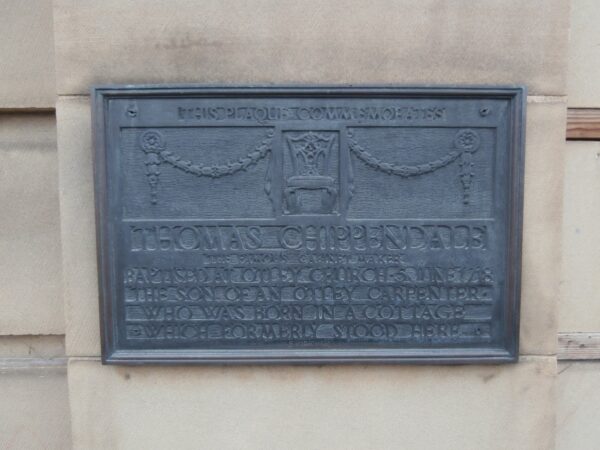The people of Otley have always been proud of their association with Thomas Chippendale ever since it was first discovered – in the years after the First World War - that the great designer and cabinet maker had been born in the small market town on the edge of the Yorkshire Dales.
The first formal recognition of this association came in 1962 when Otley Town Council and the Otley Building Society (now Skipton Building Society) commissioned a bronze plaque to be affixed to the wall of the property in Boroughgate, on the site of John Chippindale’s workshop, where it is assumed that young Thomas was born. The next year, 1963, Thomas Pickles, whose nonagenerian father Barret Pickles was a well known local historian, organised a commemorative dinner at the Royal White Horse Hotel for the 5th June that year, on Chippendale’s 245th birthday. Tickets were half a guinea and the event was sold out with over 50 participants. In particular, it seems to have been a magnet for the numerous people in Wharfedale named Chippendale, many of whom professed direct descent from the great man. The dinner was so successful that it was repeated the following year at the larger premises of the Mechanics Institute.
Something more permanent was obviously required and so on 26th January 1965 a public meeting was held and the Chippendale Society was founded. By this time it had attracted the attention of a number of local grandees, notably Sir Malcolm Stoddart Scott, MP for Ripon and the owner of Creskeld Hall nearby, who was elected President, with County Councillor Major Austin Hughes as Chairman and Thomas Pickles as Secretary.
The purposes of the Society were relatively fluid at that point but an annual dinner, an annual lecture and visits and events were all envisaged as ways in which Chippendale’s name and legacy could be celebrated and perpetuated. Right from the start it was envisaged as a locally-based Society in which the people of Otley and Wharfedale would be the principal driving force. An annual subscription of 5/- was levied, and the first annual lecture was given by Lindsey Boynton, then a lecturer at the University of Leeds.
The dinners, organised by John Holdsworth – Hon Treasurer since the Society’s foundation - were always held as near as possible to the date of Chippendale’s baptism, usually at the Golf Club, always in beautiful early summer weather with stunning views down Wharfedale. They remained a key feature of the Society’s programme with guest speakers usually from Yorkshire country houses: Lady Harewood in 1973, Lord Rosse in 1974, Sir Marcus Worsley, Lady Zetland, the Hon Simon Howard, Lady Wemyss, and Mr and the Hon Mrs Dent from Ribston Hall. With a break in tradition during the tercentenary year of 2018, we invited Mr and Mrs Anthony Coleridge.
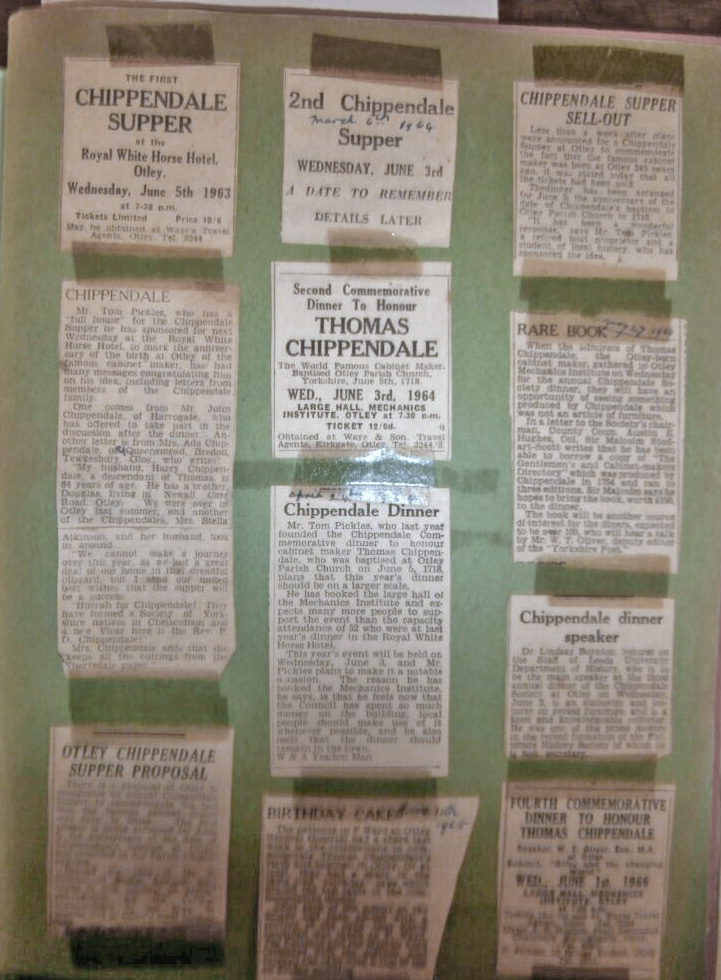
An important early event in the Society’s history was the 250th anniversary of Chippendale’s birth in 1968. The Society was the driving force in an impressive list of events which included a special service in the Parish Church, a celebrity lecture by Arthur Negus, and a local commemorative post mark. (A national postal franking was again arranged for the tercentenary date on 5th June 2018, entirely through the persistence of Deborah Gage). A more long-term memorial was the creation of a mile-long plantation of 120 native trees, used by Chippendale in his furniture, on the Danefield Estate on the Chevin, to be known as the Chippendale Ride. The Queen donated the first lime tree. In London a blue plaque was affixed to No 61 St Martin’s Lane and at Temple Newsam a major exhibition was organised, Thomas Chippendale and his Patrons in the North, curated by the 32 year-old Christopher Gilbert who soon joined the Society and began to make his mark. A joint conference was held with our sister organisation, the Furniture History Society.
Probably spurred on by all this success, the Society’s membership now soared to over 400 members, with no less than 30 committee members. In 1971 Sir Malcolm arranged for a formal Trust deed to be drawn up and lodged with the Charity Commissioners. The aims of the Society were twofold: to advance public education and to promote the appreciation and study of the work of Thomas Chippendale senior and junior; and, secondly, to acquire, preserve and maintain examples of his work for the benefit of the nation. This latter aim suggested a new and ambitious departure for a Society which had hitherto been little more than a dining and social club. The founding Chairman was Andrew Firth, who served until his death in 1987; while Simon Stell remains the longest serving member of the Committee as Hon Secretary. His firm, Last, Cawthra, Feather of Bradford has been a consistent supporter of the Society’s activities.
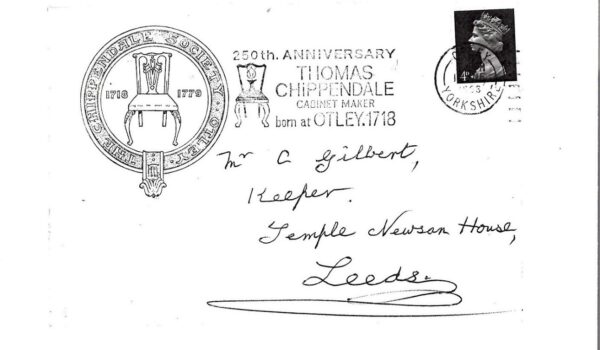
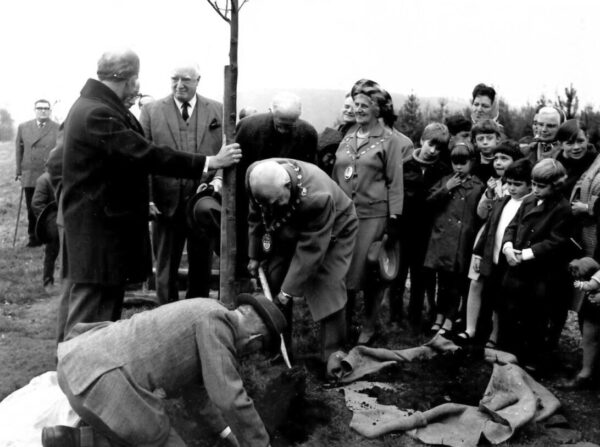
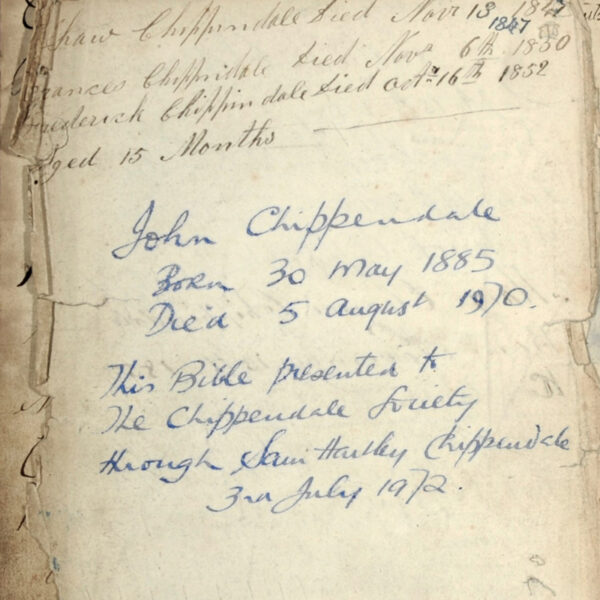
The Society had already attracted the enthusiasm of a successful local businessman and property developer, Sam Chippindale, who had established his own charitable Foundation. In 1972 he bought the Old Grammar School, also known as the Old Manor House, and offered it to the Society as the site for a new Chippendale Museum for a peppercorn rent.
To begin a collection which the museum was now to house, Sam bought a copy of the first edition of the Director for the Society (1972.1); the enigmatic portrait of Thomas Chippendale junior (1972.2); and the Chippendale family bible showing the descent of Chippendale’s half-brother’s family down to the 1960s (1972.3).
Unfortunately, the initiative for creating a Chippendale Museum in Otley was soon found to be unsustainable for obvious reasons. As a small compensation, in 1987 a statue of Chippendale was commissioned by the Foundation from Graham Ibbeson, a local sculptor, and given to the Society with a small endowment for its upkeep. Like the statue set up on the Exhibition Road façade of the V&A in 1905, by Albert Hodge, it is a generic likeness of a furniture maker, although some wags have seen in it a resemblance to the sculptor’s brother-in-law.
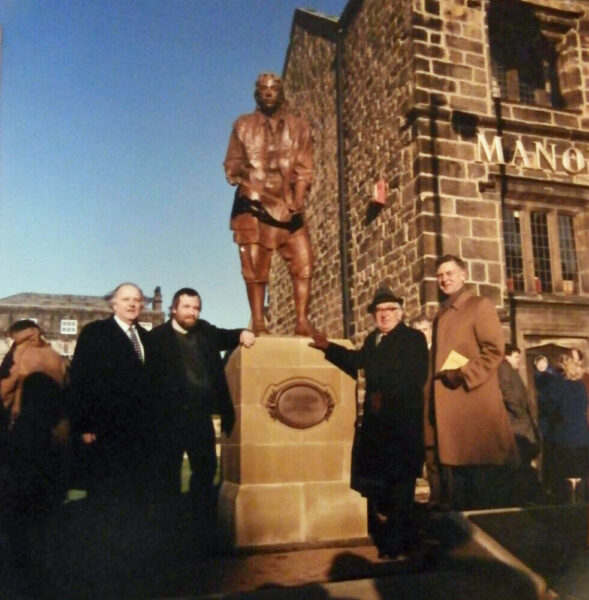
Instead, it was agreed that the Society would do better by placing its collections on permanent loan at Temple Newsam where they could be managed by Christopher Gilbert who was now appointed Honorary Curator. This clearly suited all parties as Christopher had already begun his work on his definitive book on Chippendale which was to be published in 1978.
The following couple of years saw a number of small but important additions to the collection which perhaps suggested the way in which the Society could advance Chippendale studies in a modest way which might be neglected by more formal museums: the Summary Account for Denton Hall (1973.1); a copy of John Weale’s Ornamental Designs (1973.2); the coffin furniture of Lady Heathcote (1973.4); the Caesar Crouch invitation (1975.1); Ogden Codman’s copy of Sayer’s Genteel Household Furniture (1977.1).
But these were just a prelude to our first major challenge. In 1972 a group of four original ink-and-wash drawings were sold at Sotheby’s and it seemed likely they would be exported (1975.4a-d). They had been pirated from the two albums at the Metropolitan Museum of Art, New York, but torn from the albums at an unknown date. The price for the four was £3,000, so in 1974 a fund-raising campaign was begun to raise £7,000 to secure them and set up an Acquisitions Fund. Under the Chairmanship of Sam Chippindale and the Presidency of Lady Stoddart Scott, it was brilliantly successful, and as the V&A Purchase Grant Fund, the National Art Collections Fund and the Pilgrim Trust all contributed to the purchase there were considerable funds left over.
These were used the following year towards the purchase of one of the lyre-back Brocket Hall library chairs (1976.1), a model first used by Chippendale at Nostell Priory. As all six were then on the far side of the Atlantic it was good to be able to repatriate at least one.
The collection was now established, which was as well, as important opportunities were beginning to present themselves. In 1973 Lord Harewood held the first of a number of attic sales from which we were able to secure significant items. The first, one of our greatest treasures, the side table from Lady Fleming’s Circular Dressing Room (1976.2), was in a highly distressed state on arrival. The superb marquetry was restored by David Hawkins and the later grained finish of the frame was stripped back by Simon Redburn to reveal its original painted surface.
Other important items from Harewood arrived in the 1980s, many of them requiring lengthy conservation which continued to be paid for by benefactors including Raymond Burton, the Pilgrim Trust, the Sir George Martin Trust and Simon Redburn. The white and gold fire screen from the White Drawing Room (1980.1); one of the blue and gold screens from the Saloon (1983.2), which was married to an ‘Indian Pheasant’ tapestry panel, identical to one supplied to Dumfries House in 1759, and which became available from Jon Gerstenfeld’s collection via the good agency, once again, of Simon Redburn (1987.1).
More acquisitions arrived from Harewood during the later 1980s. Most striking was the India Picture, a collage of Chinese wallpapers, which once hung in a lodging room (1986.1). Another was the remarkable figure of a crane, sold from Harewood in 1951, which once surmounted the domed daybed in Edwin Lascelles’ Couch Room, ‘an emblem of care and watchfulness’(1985.2).
One of the most important gifts to the Society’s collection was the fragment of silk damask taken from the underside of the tester from the great State Bed (1990.2). This, it will be recalled, had been crated up in the 1840s but was identified by Christopher who was permitted to remove this fragment of the original damask. By the time when the State Bed came to be reconstructed in time for the Millenium exhibition in 2000 this was was all that had survived from which a copy could be woven.
In 1992 another unmissable opportunity arose when a pair of Chippendale drawings in private hands became available for the Society to purchase. They had been found by the antique dealer Rupert Gentle tucked into a copy of the Director which he had bought at a sale in 1961 (1992.1a-b). His widow gave us the opportunity to buy them and this time it was the National Heritage Memorial Fund who came to our rescue together with Raymond Burton and the Sam Chippindale Foundation.
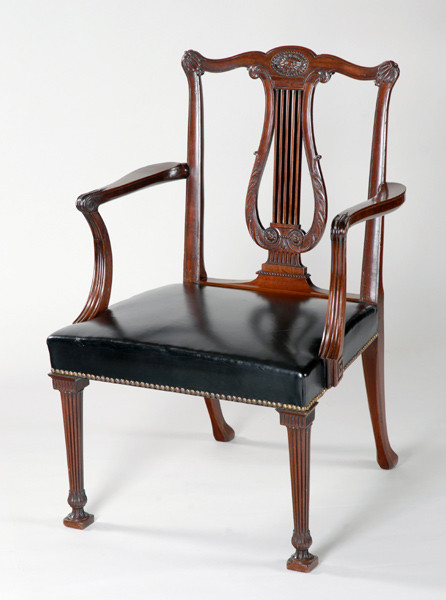
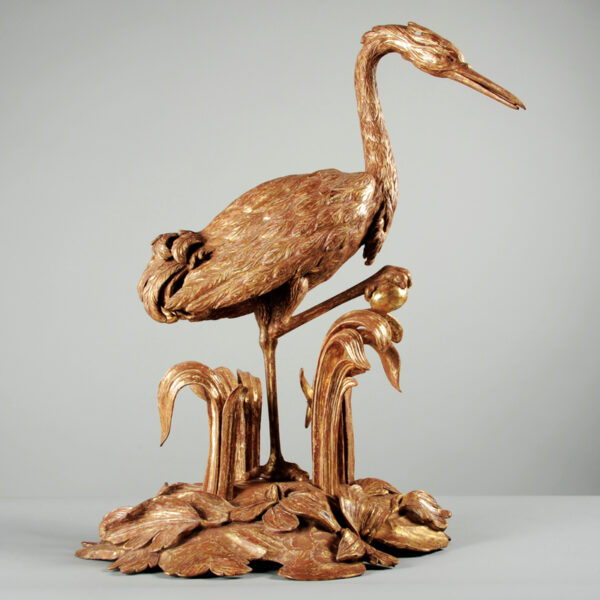
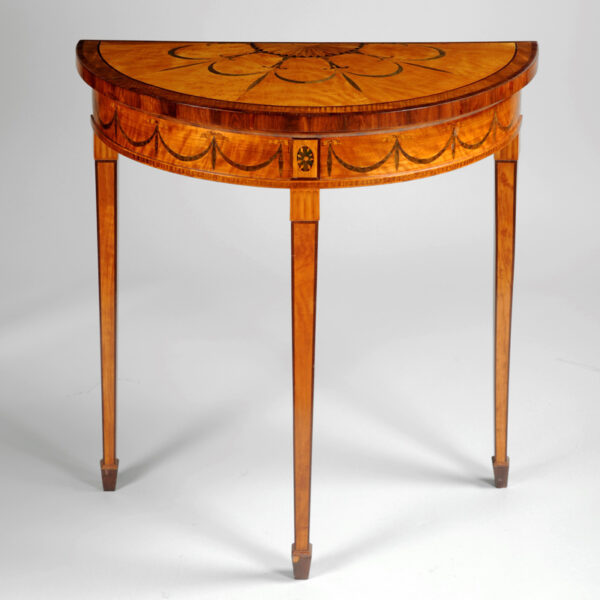
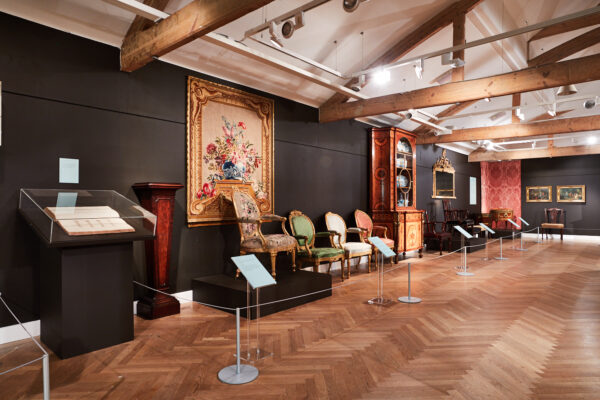
The early and mid 1990s were dominated by our attempt to achieve Registered Museum status, which now became imperative if the Society was to continue to receive grants from the official bodies. Despite everyone’s best efforts, and after a closely argued appeal, judgement went against us on the grounds that we did not own our own premises. It was a bitter blow which severely curtailed our activities, but not before we were able to acquire a fine pair of side tables via Giles Ellwood, from Denton Hall, the only house in the parish of Otley which is known to have been furnished by Chippendale (1996.1).
Christopher Gilbert, who by this time had become the Society’s President, retired from Leeds Museums and Galleries in 1995. He had just approved the purchase of a remarkable writing or music stand from Nostell when he died in the autumn of 1998. The Society was able to buy it in his memory after an appeal and it remains one of the most admired objects in the collection (1999.1).
Since Christopher’s death the Society’s activities continued in a more relaxed mode. His files have been preserved at Temple Newsam and continue to be augmented by new discoveries and other material and are frequently consulted by scholars. The dinners continued; lectures and visits - organised by Tony Mills between 2008 and 2017 - remained popular and profitable, including foreign visits to Germany, the Netherlands and Ireland. We lent no less than 26 items from the collection to the millennium exhibition at Harewood. In the same year a fully illustrated catalogue of the collection - as it then consisted - was printed. In 2004, prompted by the Mayor of Otley, Philip Coyne, we published a de-luxe facsimile of the first edition of the Director to mark its 250th anniversary. Like the original, it was funded by a group of subscribers whose names appeared on the frontispiece.
Despite our inability to attract grants from the official bodies we bought an important letter from Chippendale junior which gave the date of his final eviction from St Martin’s Lane (2000.1). With the help of Tony Lumb, who has been closely associated with the Society since at least 1973, we bought a huge Gothick organ screen dating from c1800 from Harewood Church, based on a putative Chippendale design (2001.1).
After Christopher’s death in 1998 Lord St Oswald agreed to become the Society’s President, and when the long-standing Chairman Pat Lofthouse retired in 2015 we persuaded the highly distinguished furniture historian Adam Bowett to become the new Chairman. A period of considerable activity has subsequently ensued, culminating in the tercentenary exhibition at Leeds City Museum, ultimately attracting some 40,000 visitors, and was certainly the biggest thing the Society has ever undertaken. We hope it met with the approval of our founders back in the early 1960s.
This paper was written by James Lomax and delivered in absentia by David Bower for the Furniture History Society / Chippendale Society joint symposium 2018.

